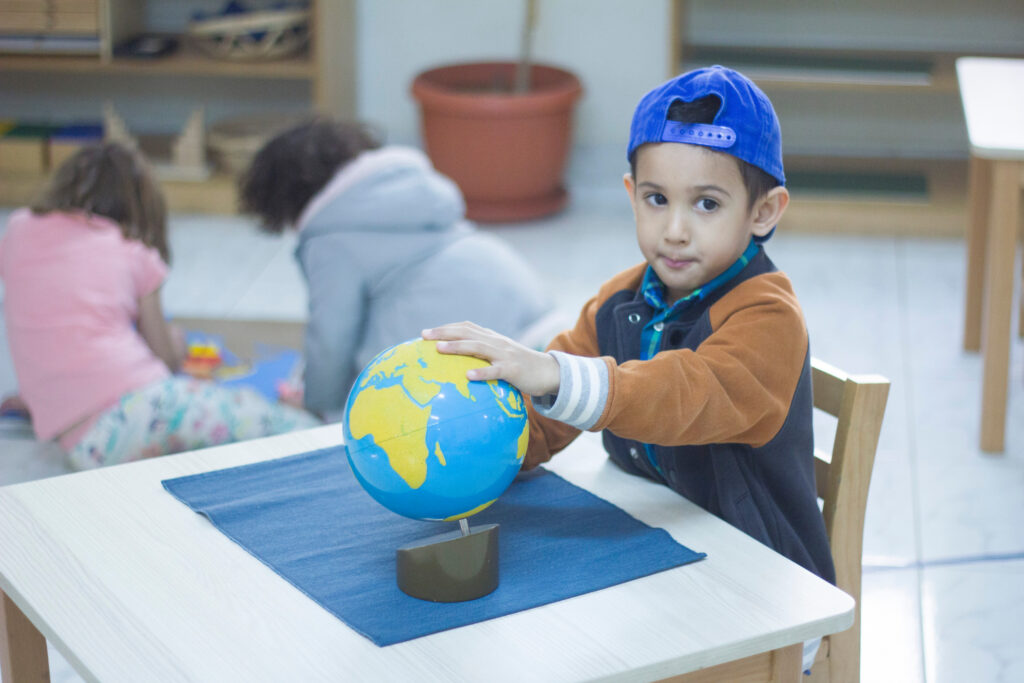Being able to teach children about geography and the world effectively is important to their education. It helps them to understand their world better and to gain a greater appreciation for where others come from as well. Because Montessori schools place an emphasis on a child directing their own learning, how does teaching geography work and why is it important?
Geography is important in Montessori learning because it allows children to understand their world better. They are able to foster a feeling of care for the earth, as well as feel more connected to people around the world. Better appreciation for cultural diversity is fostered as well.
If you are considering sending your child to a Montessori school, we’ll give you some insight into how geography is taught. We’ll also discuss how to teach Montessori geography and what a child learns in a 3-6 Montessori classroom. We’ll also give you some tips on what you can do if you want to use Montessori teaching methods with your own children.
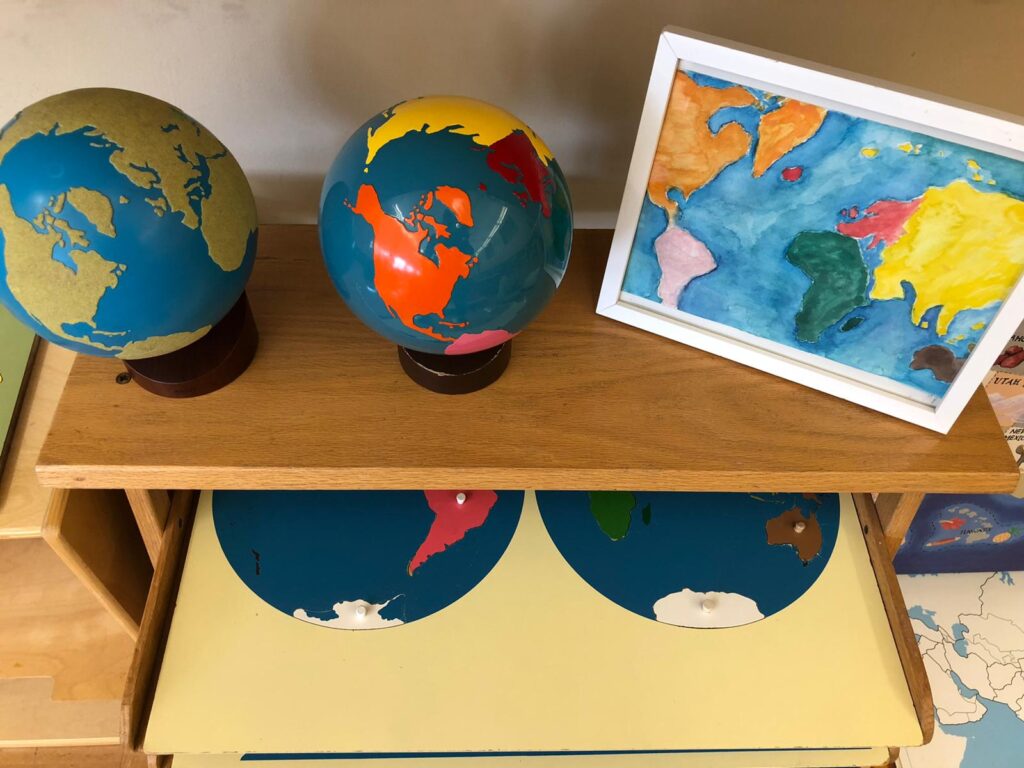
The Importance of Montessori Geography
Montessori learning has been designed to help students to understand their world in a more applicable and approachable way. The same holds true for Montessori geography. It can be considered one of the most important conceptual lessons in a Montessori school. Students learn how to form a conceptual framework which can make it easier for them to comprehend more difficult subjects easier.
Montessori geography also helps Montessori learners to gain better spatial awareness, both for themselves in relation to the rest of the world and also for where the continents are placed across the globe.
Montessori geography also helps students to learn about the human story. This can encompass the different cultures that are around the world. Students are able to learn how to appreciate the diversity that is in the world. Another teaching method that makes Montessori geography important is that the big-picture is focused on first.
Once students have a firm understanding of the larger concepts, more complex and niche concepts can be explored. This helps students to have an in-depth experience with what they are learning, which helps to create a concrete understanding of the concept they are being taught.
Teaching Montessori Geography
The whole purpose of Montessori geography is to help students understand their world better. It is to help them be able to place themselves where they live and to understand that all beings on earth have the same basic needs that they do. By working with different maps and talking about different cultures, learners gain an appreciation for how different cultures meet these same needs.
The purpose of teaching geography in Montessori schools is also to help learners better care for the earth that they live on and to realize how important the earth is. It may seem daunting to try to cover so much information in a system that places an emphasis on allowing students to direct their learning pace. However, many of these goals are integrated through the use of simple, hands-on activities. When teaching geography in a Montessori setting, you’ll want to focus on two areas: political and physical.
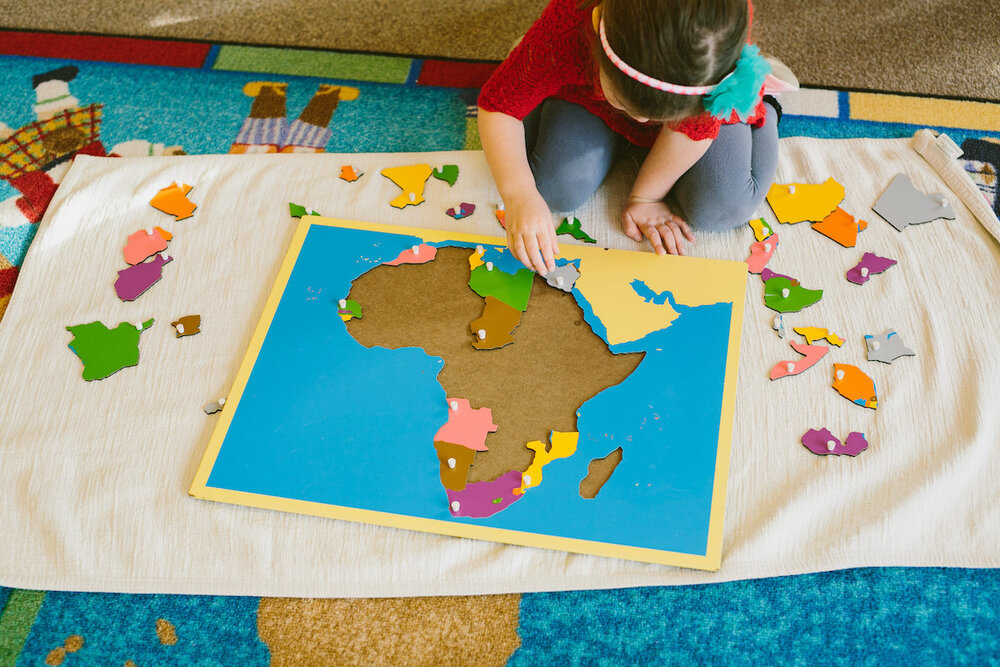
Political Geography
Political geography focuses on the names of the continents, cities in those continents, the people that live there, and the products that are made there. This helps learners to understand that they are part of a larger global system. When children are young, it can be difficult for them to comprehend that there are other places on the earth or that other people have lives as complex as their own. However, by using flags from different countries, learners can begin to understand the importance of those countries and the role they play on earth.
Another way to help students learn about political geography is for them to work with continent puzzles. The goal is not to improve their ability to solve puzzles; instead, the aim is to allow students to begin to identify how the continents fit together; how things are placed on a map. As they continue to work with the puzzles, they begin to confidently identify the different continents that exist.
Perhaps one of the strongest ways to help Montessori learners grasp a better understanding of political geography is through personalization. You can have parents come in and talk about places they have traveled and show learners the postcards they have received. If Montessori learners are able to see that their parents have been to different places in the world, it can be easier for them to comprehend the world. Or, if you are a teacher, you can bring in objects that are from around the world. Learners have a hands-on example of products that are produced in those countries.
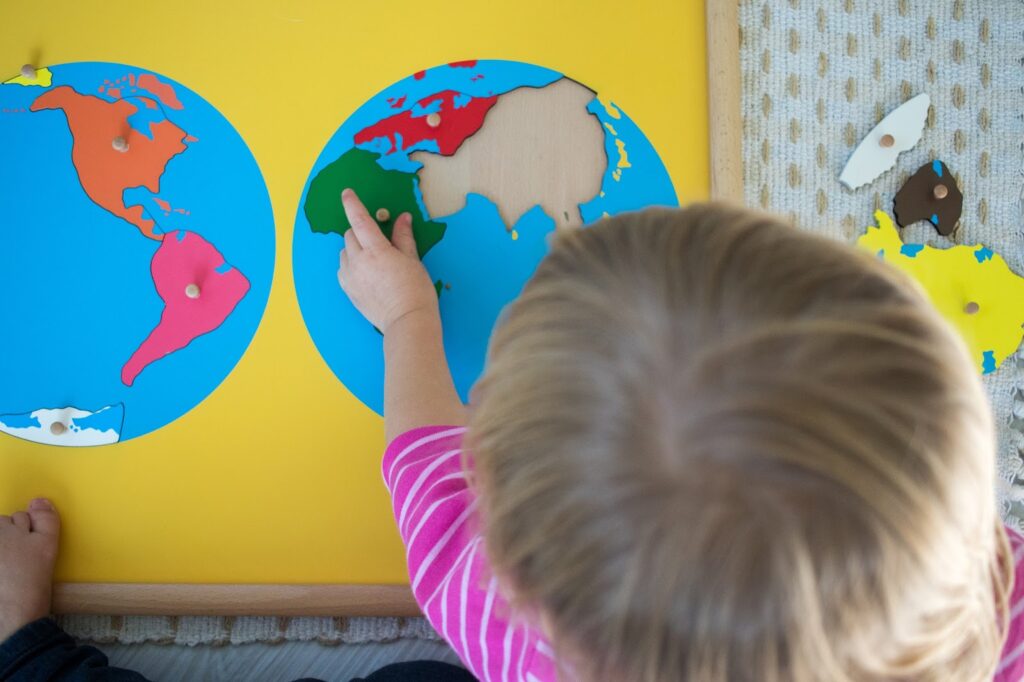
Physical Geography
Physical geography focuses on the physicality of the earth. Montessori students learn about the different types of land regions that exist (archipelagos, mountains, islands, etc.), as well as the climates that different regions have. They also learn about plants and animals that exist around the world. This helps to foster a sense of wonder for the earth they live on, which in turn, helps them to better care for their environment.
A great way to help Montessori learners grasp a more concrete understanding of land regions is to use hands-on models. For example, there may be a raised portion of land on the model that the learners can feel. The model may dip down, forming a bowl for water to be poured in by the learners. This helps them to understand how land and water interact with each other. It forms a stronger association between the solidness of land and the fluidity of water.
If you are a Montessori teacher, a great way to solidify this learning further is to take your students to see that formation for themselves. It is important that this is done in conjunction with the land formation or region they are learning about.
For example, if you are helping your Montessori learners understand what a humid climate is like, going to a zoo might prove to be a good lesson. When you are in the rainforest section, you can talk about the different regions of the world that have a similar climate. They can also see the animals that live around the world.
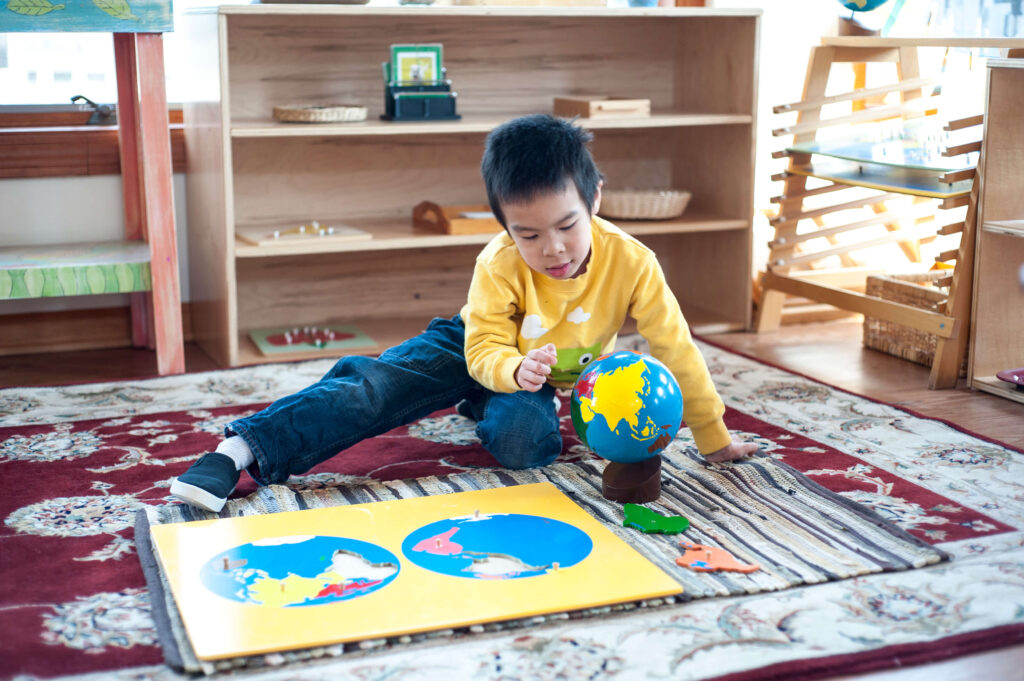
Montessori World Maps
When you begin to teach your learners about the world, there are many models that are extremely helpful. If you have younger learners, the Globe of land and water is a great introduction for them. They are able to feel the rough texture of the land and the smooth texture of the water. This helps to create a distinction between where the continents are in the world and where the water surrounds them.
If your learners are older, you can transition to using maps of the two hemispheres. Having this 2D map next to the globe is important; it will be more difficult for learners to associate the placement of the continents on a 3D globe next to a 2D map. Having the two next to each other helps them to find them more easily.
All Montessori world maps, like this one on Amazon, will have the continents in the same colors; these colors will be the same on the Montessori globe. This helps students to draw a connection between the two models more easily. North America is always orange; South America is pink; Europe is red; Africa is green; Asia is yellow; Australia is brown and Antarctica is white. By keeping this consistency, it will be easier for Montessori learners to make the transition from looking at the 3D globe to a 2D map.
Montessori Continent Maps
Teaching Montessori learners about the continents fits well into lessons involving the world map. Learners begin to make the connections between the names of the continents are more easily. The video below is a great way to do a lesson on teaching the continents to your Montessori learners.
The guide goes through a simple lesson plan to help their students understand what a hemisphere is. She does this by using an apple. The apple represents the globe and splitting in half is representative of the two hemispheres on the earth. This visual will help students see that the two hemispheres are still connected.
The instructor also has the Montessori globe and Montessori continent map next to each other. The Montessori continent map is similar to a puzzle. Each continent can be removed from the rest of the puzzle. It is important to start with one continent at a time; starting with all of them will become overwhelming. You’ll point to Asia on the globe and then remove Asia from the puzzle. Once learners are comfortable enough with this process, you can start to make this information more concrete.
You can remove a continent from the puzzle and hide it behind your back. Your Montessori learners then have the opportunity to name which continent is missing. Having the globe next to the puzzle the entire time is important. They can still refer to the globe to see which color is missing. (The names of the continents aren’t on the globe.) After they have found the continent that is missing, they get to name it and put it back in place. You can even have your learners hide a continent behind their back to help personalize this process of learning.
Having Montessori students draw out the continents on their own map is another great way for them to learn the continents. They can take the puzzle pieces from the continent map, trace them, and then color them the same color. This process of tracing helps to create a physical connection to the continents. The most important part of Montessori students learning the continents is to have a physical, hands-on component. The physical interaction that they can have with the continents helps them to better connect with the things they are learning.
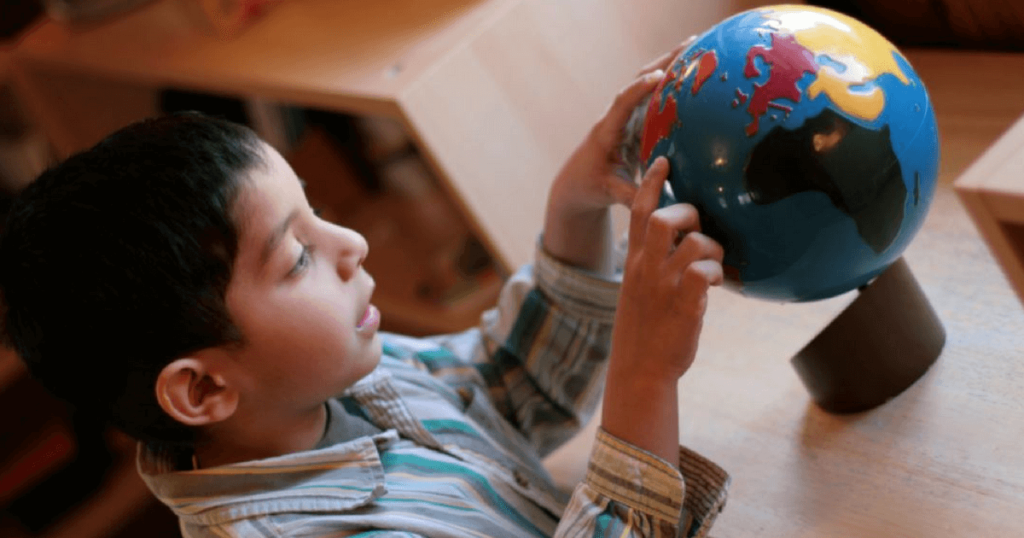
Teaching Geography to a 3-6 Montessori Classroom
As we briefly mentioned above, teaching geography to a younger audience is going to look very different compared to teaching an older group of Montessori learners. In a Montessori 3-6 classroom, the learners are aged from 3-6. This means that the level of understanding is going to vary widely for each age group.
For the younger learners, the 3- and 4-year olds, using the Globe of land and water is going to be highly effective. At this age, children are very interested in textures. Having the sandpaper feel of the land, and the smooth feel of the water is going to help establish curiosity about the earth. The younger Montessori learners can learn about different animals with miniature animals placed on the globe. At this age, children will want to know what animals there are and their names.
This can be paired nicely with learning about the continents. For example, pandas live in Asia and camels live in Africa. This simple form of naming the animals and putting them where they live will help them to more fully connect what they are learning about geography. They will be highly interested in learning about the places they live and why they live where they do.
For the older age group, 4-6, being able to have that sensory experience of feeling the different models of landforms with areas to fill the landforms with water is going to be highly effective. They can practice their care for their environment with the care they need to use while pouring the water into these different forms.
In addition to looking at and feeling the different landforms, they can practice identifying the different landforms with a 3-part card system. One identifies the type of landform, one shows a picture, and the other gives a simple explanation of what it is. They can also work on their tactile skills through working on the continent puzzle. They can also practice their map skills by drawing maps of their own home.
Students can understand that all types of people are important by showing them flags from different countries. This can be facilitated by having them carefully and respectfully carrying the flags around the room. They learn that everyone is important and deserves the same type of respect, which is a core goal of Montessori learning.
